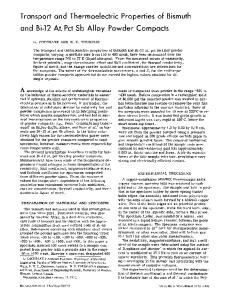Synthesis and thermoelectric properties of Ce(Ru 0.67 Rh 0.33 ) 4 Sb 12
- PDF / 163,712 Bytes
- 6 Pages / 612 x 792 pts (letter) Page_size
- 105 Downloads / 339 Views
S4.3.1
Synthesis and thermoelectric properties of Ce(Ru0.67Rh0.33)4Sb12. Geoff D. Staneff1, Paul D. Asimow2,. Thierry Caillat3 1 Department of Materials Science, California Institute of Technology Pasadena, CA 91125 2 Division of Geological and Planetary Sciences, California Institute of Technology Pasadena, CA 91125 3 Jet Propulsion Laboratory Pasadena, CA 91109 Abstract Exotic filled skutterudite compositions show promise for thermoelectric applications. Current work was undertaken with a nominal composition of Ce(Ru0.67Rh0.33)4Sb12 to experimentally verify its potential as an n-type thermoelectric material. Nominal electroneutrality was expected at 0.89 cerium filling and fully filled materials were expected to be strongly n-type. Filled precursors of the nominal composition were synthesized using straightforward solid state reaction techniques, but standard synthesis routes failed to produce a fully-filled homogenous phase. Instead, the filled thermoelectric Ce(Ru0.67Rh0.33)4Sb12 was synthesized using a combination of solid state reaction of elemental constituents and high pressure hot pressing. A range of pressuretemperature conditions was explored; the upper temperature limit of filled skutterudite in this system decreases with increasing pressure and disappears by 12 GPa. The optimal synthesis was performed in multi-anvil devices at 4-6 GPa pressure and dwell temperatures of 350-700 ˚C. rutheniumThe result of this work, a Ce(Ru0.67Rh0.33)4Sb12 fully filled skutterudite material, exhibited unexpected p-type conductivity and an electrical resistance of 1.755 mΩ−cm that increased with temperature. Thermal conductivity, Seebeck coefficient, and resistivity were measured on single phase samples. In this paper, we report the details of the synthesis routeand measured thermoelectric properties, speculate on the deviation from expected carrier charge balance, and discuss implications for other filled skutterudite systems. Introduction In nature, skutterudite is a mineral of composition (Co,Ni)As3-x. Its structure has a number of peculiar electrical and thermal properties that suggest an excellent potential for use in thermoelectric devices. This combination springs from the relatively complicated structure of the simple binary CoAs3 compound. The skutterudite unit cell is comprised of thirtytwo atoms arranged in a cubic array of corner shared octahedra. These octahedra contain a central cobalt atom surrounded by six shared arsenic atoms. The misalignment of this array creates large void sites between the octahedra and in practice there is significant freedom for chemical substitution on all three of these crystallographic sites. Many transition metals can occupy the cobalt site, either as sole occupants or in solid solution with other transition metals even of disparate valence states. Likewise, the pnictides (P, As, Sb, Bi) can all form skutterudites. The As site can also be doped either p-type with the removal of electrons with a GeSb· substitution or n-type with the addition of electrons with a TeSb′ substitution
Data Loading...











